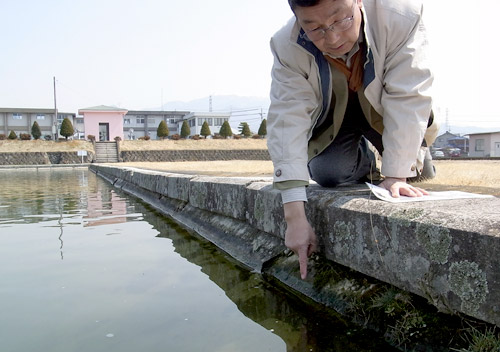
from Across Japan vol. 58 2011.09.05 Let's bring about real change to the water infrastructure! Taking another look at ecological purification systems
![]()
- Water supply and sewage systems use a ton of electricity
- Energy the current water infrastructure requires
- Ecological purification systems are safe, low cost, and energy saving
- Disadvantages of rapid sand filtration
- A town that implemented the ecological purification system as a measure against protozoa
- Kenzaki water treatment plant, a beer company's choice
- Maintenance-free Nishihara water treatment plant
- Ecological purification systems are being reexamined in various regions across Japan
- Slow sand filtration system that saved marginal settlements
- Nishino and Sunaharai water treatment plants create energy
Japanese society has evolved with a fixation on achieving efficiency by centralizing and expanding in scale. But the Great East Japan Earthquake has brought the disadvantages of such ways to light. Because one power plant fell, electricity disappeared from many towns. Similarly, when one water treatment plant faced operational issues, we no longer had drinking water that we had taken for granted. These issues have got people starting to think about decentralization and energy on a smaller scale, but it may also be necessary to start thinking about water in the same way. We need make a shift towards "safe," "low cost," and "energy-saving" water systems. This shift is essential for realizing a sustainable small-scale community. Specifically, we need to reexamine the source of our water, how we purify it, and how sewage is processed. In this report, let us take a closer look at the ecological purification of water (slow sand filtration), which has begun to draw attention in Japan after the earthquake.
目次へ移動 Water supply and sewage systems use a ton of electricity
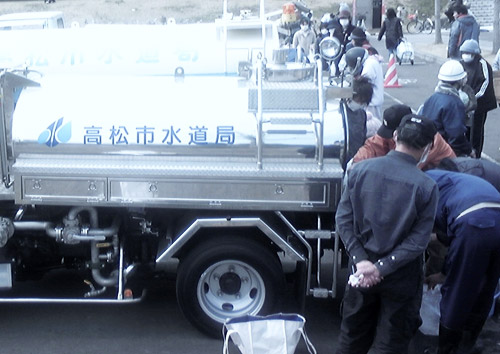 People being rationed water in an area affected by the earthquake/tsunami
People being rationed water in an area affected by the earthquake/tsunami
The M9.0 earthquake that struck Japan on March 11 and the subsequent tsunami had a devastating effect on our infrastructure including the water supply, which is a very vital lifeline.
The water pipes were destroyed and water flooded the streets. The ground near the water treatment plant sunk and the water reservoirs were destroyed. There were many water treatment plants that lost electricity and could not operate. We realized once again that in order to have water, we needed electricity. 2.2 million homes mainly in Iwate, Miyagi, Fukushima, Ibaraki, and Chiba prefectures went without water.
But there were some water treatment plants that continued to be in operation. For example, The Ookaido water treatment plant located in Ishimaki city, an area devastated by the disaster, continued to supply clean water and became a water-rationing center even though it had lost its electricity supply. The plant withstood fierce tremors and continued to function. What made this possible?
目次へ移動 Energy the current water infrastructure requires
By the way, do you know which water treatment plant supplies water to your home? The quality of water and the cost and energy it takes to purify the water differs depending on the plant.
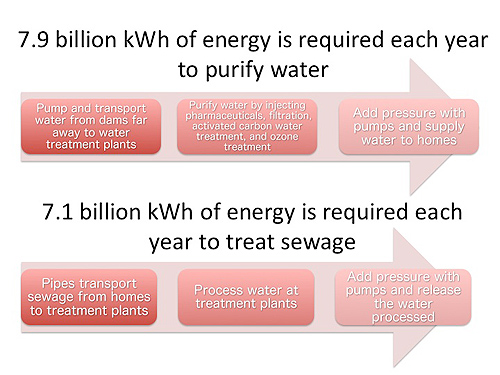 Energy required for water and sewage treatment
Energy required for water and sewage treatment
A lot of energy is required to supply water and treat sewage. It takes approximately 7.9 billion kWh each year to transport water from the source, purify the water, and supply water to people's homes. Likewise, to collect sewage, process the waste, and release the water, it takes 7.1 billion kWh each year. Together, it takes approximately 15 billion kWh, which is equivalent to the total energy created by 1.5 nuclear power reactors a year.
There are 3 ways to filtrate water: slow sand filtration, rapid sand filtration, and membrane filtration. When you rank these filtration methods by their energy efficiency, the order would be as follows: slow sand filtration, rapid sand filtration, and membrane filtration.
目次へ移動 Ecological purification systems are safe, low cost, and energy saving
We spoke to Mr. Nobutada Nakamoto (chairman of the Community Water Supply Support Center of Japanemeritus professor of Shinshu University), who is an expert in slow sand filtration.
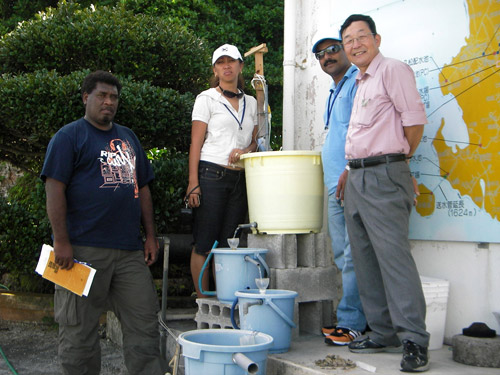 Mr. Nakamoto taught about a simplified mechanism for slow sand filtration at a JICA(Japan International Cooperation Agency) workshop (far right).
Mr. Nakamoto taught about a simplified mechanism for slow sand filtration at a JICA(Japan International Cooperation Agency) workshop (far right).
"Slow sand filtration has been around for a very long time. Water becomes purified as it slowly runs through the sand.
Actually, organisms invisible to the naked eye found on the surface of the top filtration layer purify the water. They work quite fast; they are not at all slow.
This method, which uses nature rather than chemicals, is a compact representation of how the soil in the forest purifies water.
Even immediately after the earthquake/tsunami struck, water treatment plants that treated water using an ecological purification system (slow sand filtration method) were able to continue supplying safe drinking water.
Why? Because they have a simple and durable structure, they do not require electricity to treat water, and you don't need any chemicals other than chlorine. Even under difficult circumstances, the water treatment plant managed to maintain its usual operability."
There is also data that supports its superior performance when it comes to removing radioactive substances from water (Report No. 28 by the Shimane Prefectural Institute of Public Health and Environmental Science). This method removes 34-38% iodine-131, 66-68% ruthenium-103, and 82% cesium-137.
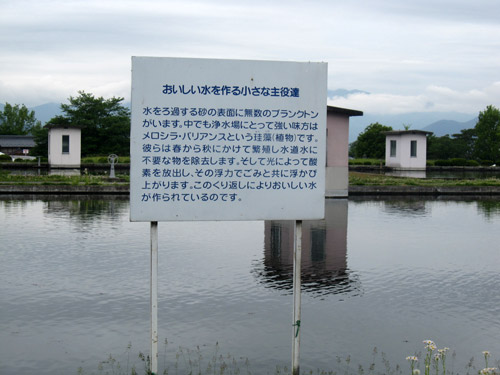 Koshigoe water treatment plant located in Ueda city, Nagano prefecture.
Koshigoe water treatment plant located in Ueda city, Nagano prefecture.
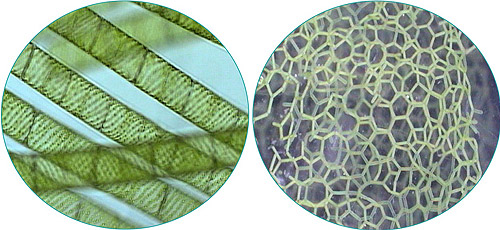 Organisms on the surface of the biolayer.
Organisms on the surface of the biolayer.
目次へ移動 Disadvantages of rapid sand filtration
The most prevalent purification method today is rapid sand filtration. Initially, most water treatment plants used ecological purification systems, but after the war many water treatment plants switched to rapid sand filtration.
Rapid sand filtration can make large quantities of water very rapidly by using chemicals (flocculation agents) to sink contaminants in the water to the bottom, and filtering the water on the upper surface using pebbles and sand.
There are disadvantages to such "large scale," "centralized" purification facilities. First of all, this process cannot remove water-soluble organic matter and ammonia, so you need to kill bacteria using chlorine. Moreover, it also cannot remove manganese, odor, synthetic detergents, etc. so the water does not taste as great.
That is why water from the pipes in metropolitan areas such as Tokyo began incorporating additional processes such as ozone treatment and activated carbon water treatment to get rid of substances that cause moldy smell or the smell of chlorine that rapid sand filtration is unable to.
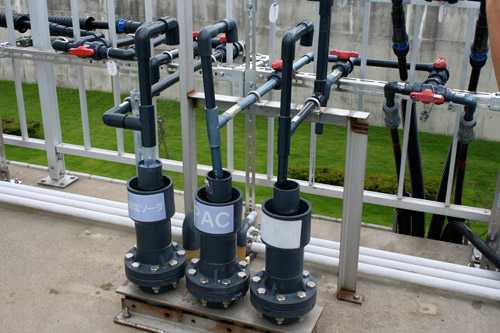 Flocculation agents being injected at water treatment plants that use rapid sand filtration.
Flocculation agents being injected at water treatment plants that use rapid sand filtration.
In the past, the water has been polluted by protozoa called cryptosporidium, which caused an outbreak of diarrhea. Cryptosporidium cannot be killed with chlorine, so the use of membrane filtration (which uses a filter with micro pores that removes turbidity and contaminants from raw water) was recommended.
Mr. Nakamoto explains.
"By shifting from ecological purification to rapid sand filtration, we were able to meet the rapid increase in water demand with large-scale, centralized water treatment plants. And the maintenance and management could also be automated. But on the other hand, issues with mold and cryptosporidium pollution is a technological "loop hole" that is associated with rapid sand filtration. We would not have had to face such issues had we stuck with ecological purification."
New processes were introduced such as activated carbon water treatment, ozone treatment, and membrane filtration, to address these technological issues. But this required more capital investment, increased the cost of consumables, and more energy was required, so financing became very difficult. In principle, the cost of water is divided among the number of users, so the smaller the community, the more expensive the cost of using water.
The cost of water differs significantly from local government to local government. If we compare the cost for using 20 tons of water per month, the average usage per household (20mm diameter faucet, as of April 2010), the most expensive water can be found in the Kyumisumi town, Uki city, Kumamoto prefecture, where the monthly cost of water is 12,600 yen, and the cheapest water at 840 yen can be found in the Kyuashigawa town of Fuefuki city, Yamanashi prefecture.
目次へ移動 A town that implemented the ecological purification system as a measure against protozoa
In 1997, the Tetta town (currently known as Niimi city), Okayama prefecture received notice from the water quality inspection agency that cryptosporidium (protozoa) or something of the like was found in the water. The Ministry of Health and Welfare (now Ministry of Health, Labour and Welfare) issued an immediate directive to cease supplying water and to purify the water.
We spoke to the person in charge of the water facility of Tetta town and asked what it was like back then.
"Tetta was blessed with water of such great quality, we actually didn't really need a purification facility. But because of this problem, we had to establish a new water treatment plant to supply water."
Many meetings were held in town. In the end, to supply "great water safely," we decided to build an ecological purification system (slow sand filtration).
The Ministry of Health and Welfare accepted all 3 filtration methods - rapid sand filtration, slow sand filtration, and membrane filtration - as a measure against cryptosporidium, but it initially only provided subsidies to plants that chose to use membrane filtration (later, it was decided to provide subsidies to all methods). But the town of Tetsuta still chose to implement the ecological purification system (slow sand filtration). The person in charge explained why.
"It was because the construction, maintenance, and management costs were low. Also, with rapid sand filtration, you would need to use significantly more chlorine than in the past, so we thought that there would be higher health risks for our residents."
目次へ移動 Kenzaki water treatment plant, a beer company's choice
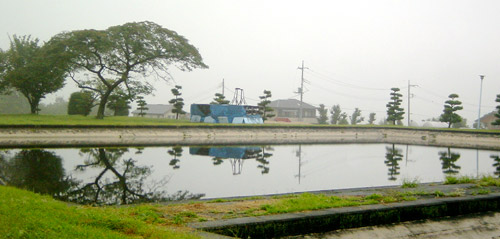 Kenzaki water treatment plant
Kenzaki water treatment plant
The Kenzaki water treatment plant located in Takasaki city, Gunma prefecture, is the oldest water plant in Takasaki, erected in 1910 (Meiji 43). Water treatment plants that employ ecological purification have a very simple and robust structure, so plants built during the Meiji and Taisho era are still in operation.
Kirin Beer used to have a factory here. When building their brewery, they checked the raw water and water pipes in various regions in Japan, and chose this place.
I went to this water plant, and asked them to make an exception and let me drink their water. They gave me a cup of water that had just been filtered, without any chlorine (it is required by law to first add chlorine before you supply water). The person in charge at the plant placed the cup full of water on a top of a red line he drew on a piece of paper.
"Look how transparent it is. Isn't it great?"
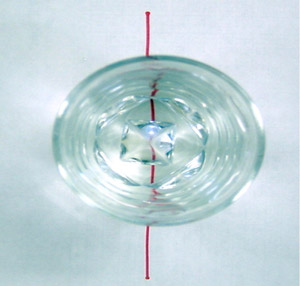 If you can see the red line clearly, that means that the water is pure.
If you can see the red line clearly, that means that the water is pure.
I do this often myself to check the transparency of water, but I had never seen the red line appear so clearly before. "Please take a sip." The water tasted a bit sweet. It was clear, refreshing, and yet full of flavor. Then they gave me coffee made with the water. The coffee was truly unforgettable.
The Kenzaki water treatment plant transports water from the Karasugawa River store in the floodgates of Kasuga in the town of Haruna, Gunma prefecture by using the difference in elevation of the land. It does not require the use of energy to source water, so it is really an ideal plant.
目次へ移動 Maintenance-free Nishihara water treatment plant
If you manage the ecological purification system well, it hardly requires any maintenance. All you have to do is occasionally remove the algae and the dirty mud in the sand filtration tub.
The Nishihara water treatment plant located in Suzaka city, Nagano prefecture uses the ecological water purification system. It is a small, unmanned water treatment plant located in the middle of a grassy field. The only electronic device you will find is the meter. Not only do you not need to maintenance equipment, you don't even have to manage the plant.
According to the person in charge of the water treatment plant at Suzaka city, "The plant began operation in 2004, but we have not had to maintenance it once since." But the water is of such great quality, it is being bottled and sold ("Kuramizu." Currently not on sale).
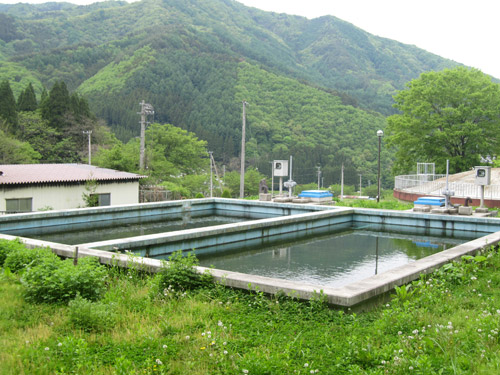 Nishihara water treatment plant
Nishihara water treatment plant
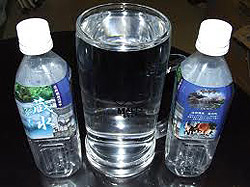 Kuramizu
Kuramizu
Mr. Nakamoto explained. "What is important with ecological water purification is to create a proper environment where the biotic community can do its work. As long as you do that, you don't have to do much else.
Because the term, "slow sand filtration" is widely recognized, people think water must be filtered slowly, and that the amount of water this filtration method can provide is limited. This is not necessarily true. If you look at water flowing through nature, the flow could be quite rapid, but clear water still gushes from the wellspring.
In fact, what is important is that you don't change the speed at which the water flows. Even if it is fast, if the flow is constant, the biological community will remain active. "
目次へ移動 Ecological purification systems are being reexamined in various regions across Japan
Many people in the water business have begun to reexamine the ecological water purification system because it is safe, costs little, and saves energy.
The Nishino water treatment plant in Mihara city of Hiroshima prefecture used to use both rapid sand filtration and ecological water purification, but in 2004, they made a complete shift to ecological water purification.
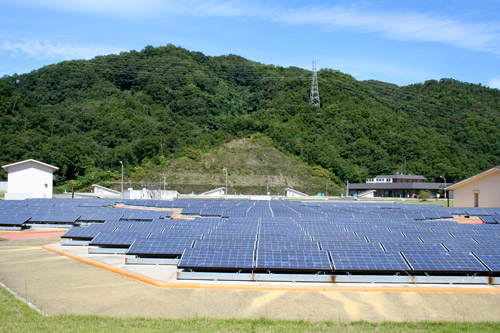 The Nishino water treatment plant in Mihara city, Hiroshima prefecture.
The Nishino water treatment plant in Mihara city, Hiroshima prefecture.
A water treatment plant incorporating the ecological water purification system began operation in the town of Misato in Miyagi prefecture in 2008. The person in charge of the plant said:
"Until recently, we also used rapid sand filtration to supplement water treatment, but the aging system needed renovation, so we implemented a new system. We listened to the feedback of our residents, and decided to use slow sand filtration. The key benefits that helped up make this decision was the system's ability to make good water at low cost."
The Irabu Island in Okinawa prefecture used the ecological water purification method, but later installed rapid sand filtration and membrane filtration. This resulted in huge costs and excessive debt. When the island merged its administration with Miyako city, it made the shift to ecological purification and membrane filtration and thus the plant has begun to reduce costs.
The Chatan water treatment plant located in Chatan town, Okinawa prefecture, built a desalinization facility. Operating this facility required an enormous amount of money for maintenance and thus created great deficits. So the facility is now only operated in case of emergencies.
目次へ移動 Slow sand filtration system that saved marginal settlements
In the folds of the mountains in Oita prefecture, there are marginal settlements with only a dozen or so residents. The person in charge of a water treatment facility in Oita described the situation as follows:
"The network of water pipes do not reach these settlements, so they have relied on water from shallow wells from long ago. But in recent years, the water tested positive for iron, manganese, and bacteria, so the water is no longer fit for drinking. But it is financially difficult to construct pipes all the way to these settlements with only a dozen or so residents. That is why we set up an ecological water purification unit."
When you place stones and sand in this metal container and filter the well water through the device, the biological community goes to work and creates clean water.
"We can now supply safe drinking water at a very low cost of a little over a thousand dollars. We are gathering a wealth of data right now, and are considering making this device available for sale as soon as we know that they can be used stably."
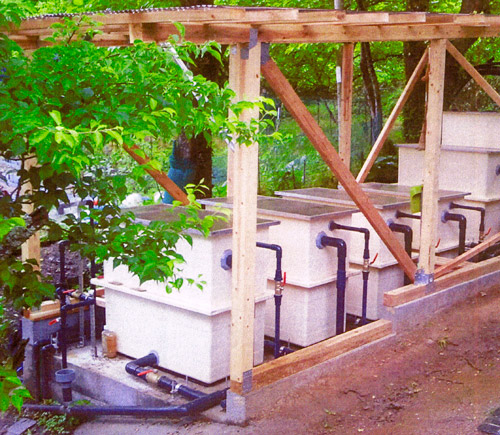 Ecological water purification unit creates clean water for small settlements in Oita
Ecological water purification unit creates clean water for small settlements in Oita
Running a water business in these times is very tough. That is why the Ministry of Health, Labour, and Welfare has launched an "expansion" initiative to take advantage of economies of scale, but applying this to settlements of such small scale may be difficult. In such cases, these ecological water purification units (slow sand filtration) will be very useful.
目次へ移動 Nishino and Sunaharai water treatment plants create energy
At the Nishino water treatment plant in Mihara city, Hiroshima prefecture, the land above the underground reservoir containing treated water is being effectively used. Solar power generation devices have been installed to general approximately 11,000 kWh of electricity annually. Although the ecological purification system itself doesn't require electricity, the solar power generation supplies 15.2% of electricity the Nishino water treatment plant requires.
If the performance of solar power generation systems rises and costs decrease in the future, more energy can be generated. Water treatment plants will become self-sufficient when it comes to energy and may even become an energy base.
The installation costs of solar power generation modules are high, and so it doesn't make financial sense. But the Sunaharai water treatment plant in Iida city, Nagano prefecture, took advantage of funds operated by Ohisama Energy Fund Co., Ltd. to install solar power generation panels.
Mr. Hara, the president of Ohisama Energy Fund explained.
"Solar power generation panels at the Sunaharai water treatment plant were set up using funds invested by local residents. These solar power generation panels are generating more energy than the plant needs, so the remainder is sold back to Chubu Electric Power and the profits returned to investors. Water treatment plants are on large pieces of land, so they have the potential to provide both water and electricity."
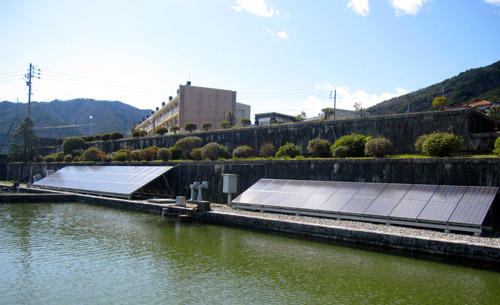 Sunaharai water treatment plant in Iida city, Nagano prefecture.
Sunaharai water treatment plant in Iida city, Nagano prefecture.
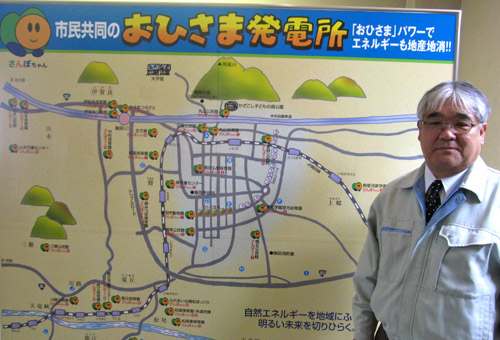 Mr. Akihiro Hara, the president of the Ohisama Energy Fund.
Mr. Akihiro Hara, the president of the Ohisama Energy Fund.
We use water from the tap without really giving it much thought, but a lot of cost and energy goes into creating the water. Reducing the cost and energy required, yet continuing to provide safe drinking water is very important. The ecological purification system is a key technology for making the shift towards "safe," "low cost," and "energy saving" water supply.
Author profile
Junji Hashimoto
Writer, representative of Aqua-sphere, and the water conservation leader of the ( Japan Water Forum. )With hopes for fair and sustainable use of water, he researches and writes about various water issues in Japan. At the same time, he conducts "seminars on water" to communicate the importance of water and the situations in various different countries to audiences of all ages. His works include, "Japanese have yet to realize how important water issues are" (PHP Kenkyujyo), "Delicious water, clean water" (Nippon Jitsugyo Publishing), and "Shifting from 6.70 billion people 'scrambling' for water to 'sustainability'" (Nikkei Publishing). He is also the vice principal of the Think the Earth Project's "Water School."
Report, original text, and photographs by: Junji Hashimoto
Translated by: Yuri Morikawa(Oxygen Inc.)
Edited by: Miho Kazama, Soichi Ueda (Think the Earth Project)















